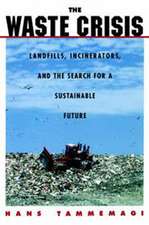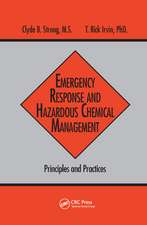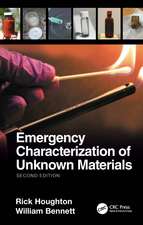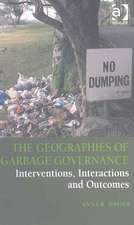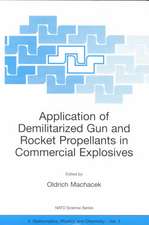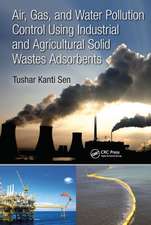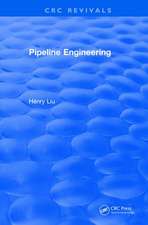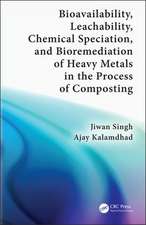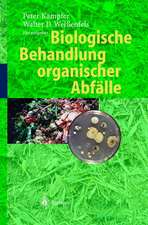Sustainable Bioconversion of Waste to Value Added Products: Advances in Science, Technology & Innovation
Editat de Inamuddin, Anish Khanen Limba Engleză Paperback – 21 apr 2022
Nowadays, the industrial revolution and urbanization have made human life comfortable. However, this requires excess usage of natural resources starting from food and food products, to energy resources, materials as well as chemicals. The excess use of natural resources for human comfort is expected to high fuel prices, decline natural resources as well as cause a huge hike in the cost of raw materials. These factors are pushing researchers to grow environmentally friendly processes and techniques based on inexpensive and sustainable feedstock to accomplish such worldwide targets. Bioconversion, otherwise called biotransformation, is the change of natural materials, for example, plant or animal waste, into usable items or energy sources by microorganisms. Bioconversion is an environmentally friendly benevolent choice to supplant the well-established chemical procedures utilized these days for the production of chemicals and fuels. A variety of alternatives advancements are being considered and are directly accessible to acquire diverse valuable end-products through bioprocesses. This book discusses in detail the process and techniques of bioconversion by focusing on the organic feedstock of animal and plant origin. It brings solutions to the bioconversion of various feedstock into value-added products.
| Toate formatele și edițiile | Preț | Express |
|---|---|---|
| Paperback (1) | 1233.37 lei 43-57 zile | |
| Springer International Publishing – 21 apr 2022 | 1233.37 lei 43-57 zile | |
| Hardback (1) | 1241.73 lei 22-36 zile | |
| Springer International Publishing – 21 apr 2021 | 1241.73 lei 22-36 zile |
Din seria Advances in Science, Technology & Innovation
- 18%
 Preț: 2114.60 lei
Preț: 2114.60 lei - 20%
 Preț: 1081.52 lei
Preț: 1081.52 lei - 18%
 Preț: 1254.36 lei
Preț: 1254.36 lei - 18%
 Preț: 1243.29 lei
Preț: 1243.29 lei - 18%
 Preț: 799.79 lei
Preț: 799.79 lei - 18%
 Preț: 1566.90 lei
Preț: 1566.90 lei - 18%
 Preț: 2135.11 lei
Preț: 2135.11 lei - 18%
 Preț: 1699.47 lei
Preț: 1699.47 lei - 18%
 Preț: 1248.02 lei
Preț: 1248.02 lei - 15%
 Preț: 653.14 lei
Preț: 653.14 lei - 15%
 Preț: 666.24 lei
Preț: 666.24 lei - 18%
 Preț: 1677.26 lei
Preț: 1677.26 lei - 18%
 Preț: 1444.55 lei
Preț: 1444.55 lei - 15%
 Preț: 653.14 lei
Preț: 653.14 lei - 18%
 Preț: 1248.20 lei
Preț: 1248.20 lei - 18%
 Preț: 1233.83 lei
Preț: 1233.83 lei - 18%
 Preț: 1565.29 lei
Preț: 1565.29 lei - 18%
 Preț: 1403.52 lei
Preț: 1403.52 lei - 18%
 Preț: 1121.76 lei
Preț: 1121.76 lei - 18%
 Preț: 1400.35 lei
Preț: 1400.35 lei - 18%
 Preț: 1392.46 lei
Preț: 1392.46 lei - 18%
 Preț: 1121.76 lei
Preț: 1121.76 lei - 18%
 Preț: 1405.09 lei
Preț: 1405.09 lei - 15%
 Preț: 653.14 lei
Preț: 653.14 lei - 18%
 Preț: 1834.58 lei
Preț: 1834.58 lei - 18%
 Preț: 948.92 lei
Preț: 948.92 lei - 15%
 Preț: 648.24 lei
Preț: 648.24 lei - 18%
 Preț: 1230.66 lei
Preț: 1230.66 lei - 15%
 Preț: 704.69 lei
Preț: 704.69 lei - 20%
 Preț: 1167.33 lei
Preț: 1167.33 lei - 18%
 Preț: 1866.00 lei
Preț: 1866.00 lei - 18%
 Preț: 1128.08 lei
Preț: 1128.08 lei - 18%
 Preț: 972.62 lei
Preț: 972.62 lei - 18%
 Preț: 967.40 lei
Preț: 967.40 lei - 18%
 Preț: 900.80 lei
Preț: 900.80 lei - 18%
 Preț: 1008.12 lei
Preț: 1008.12 lei - 15%
 Preț: 646.62 lei
Preț: 646.62 lei - 18%
 Preț: 1128.08 lei
Preț: 1128.08 lei - 18%
 Preț: 1402.35 lei
Preț: 1402.35 lei - 18%
 Preț: 1576.37 lei
Preț: 1576.37 lei - 15%
 Preț: 601.60 lei
Preț: 601.60 lei - 18%
 Preț: 1211.72 lei
Preț: 1211.72 lei - 20%
 Preț: 673.17 lei
Preț: 673.17 lei - 15%
 Preț: 651.51 lei
Preț: 651.51 lei - 18%
 Preț: 1242.83 lei
Preț: 1242.83 lei - 18%
 Preț: 1248.68 lei
Preț: 1248.68 lei - 18%
 Preț: 1233.83 lei
Preț: 1233.83 lei - 18%
 Preț: 1587.39 lei
Preț: 1587.39 lei - 18%
 Preț: 1241.73 lei
Preț: 1241.73 lei - 5%
 Preț: 1322.29 lei
Preț: 1322.29 lei
Preț: 1233.37 lei
Preț vechi: 1504.11 lei
-18% Nou
Puncte Express: 1850
Preț estimativ în valută:
236.04€ • 245.51$ • 194.86£
236.04€ • 245.51$ • 194.86£
Carte tipărită la comandă
Livrare economică 14-28 aprilie
Preluare comenzi: 021 569.72.76
Specificații
ISBN-13: 9783030618391
ISBN-10: 3030618390
Pagini: 393
Ilustrații: VI, 393 p. 133 illus., 109 illus. in color.
Dimensiuni: 210 x 279 mm
Greutate: 0.89 kg
Ediția:1st ed. 2021
Editura: Springer International Publishing
Colecția Springer
Seria Advances in Science, Technology & Innovation
Locul publicării:Cham, Switzerland
ISBN-10: 3030618390
Pagini: 393
Ilustrații: VI, 393 p. 133 illus., 109 illus. in color.
Dimensiuni: 210 x 279 mm
Greutate: 0.89 kg
Ediția:1st ed. 2021
Editura: Springer International Publishing
Colecția Springer
Seria Advances in Science, Technology & Innovation
Locul publicării:Cham, Switzerland
Cuprins
Bioconversion of biowastes for energy applications.- Green and sustainable biomass processing for fuels and chemicals.- Bioconversion of food waste into ethanol.- Bioconversion of lignocellulosic residues into hydrogen.- Palm oil industry − processes, by-product treatment and value-addition.- Bionanocomposites derived from polysaccharides: green fabrication and applications.- Multi-utilization of cow dung as biomass.
Notă biografică
Dr. Inamuddin is currently working as assistant professor in the chemistry department of Faculty of Science, King Abdulaziz University, Jeddah, Saudi Arabia. He is also a permanent faculty member (assistant professor) at the Department of Applied Chemistry, Aligarh Muslim University, Aligarh, India. He has extensive research experience in multidisciplinary fields of analytical chemistry, materials chemistry, and electrochemistry and, more specifically, renewable energy and environment.
Prof. Abdullah M. Asiri is the Head of the Chemistry Department at King Abdulaziz University since October 2009 and he is the founder and the Director of the Center of Excellence for Advanced Materials Research (CEAMR) since 2010 till now. He is a Professor of Organic Photochemistry. He graduated from King Abdulaziz University (KAU) with a BSc in Chemistry in 1990 and a PhD from University of Wales, College of Cardiff, UK in 1995. He was promoted to a Professor in 2004. His research interest covers color chemistry, synthesis of novel photochromic, thermochromic systems, synthesis of novel coloring matters and dyeing of textiles, Materials Chemistry, Nanochemistry and nanotechnology Polymers and plastics. Prof. Asiri is the principal supervisors of more than 17Msc and one two PhD thesis; He is the main Author of ten books in different chemistry disciplines. He Published more than 400 research Papers in international Journals. Prof. Asiri is the Editor-in-Chief of King Abdulaziz University Journal of Science. A major achievement of Prof. Asiri is the discovery of tribochromic compounds, a class of compounds which change from slightly or colorless to deep colored when subjected to small pressure or when grind. This discovery was introduced to the scientific community as a new terminology Published by IUPAC in 2000. This discovery was awarded a patent from European Patent office and from UK patent and some other patents office in Europe. Prof. Asiri involved in many committees at the KAU level and also on the national level, he took a major role in the Advanced materials committee working for KACST to identify the National plan for science and technology in 2007. Prof. Asiri played a major role in advancing the chemistry education and research in KAU, he has been awarded the best Researchers from KAU for the past four years. He also awarded the Young Scientist award from the Saudi Chemical society in 2009, and also the first prize for the distinction in science from the Saudi chemical society in 2012. He also received a recognition certificate from the American Chemical society (Gulf region Chapter) for the advancement of chemical science in the Kingdome. Also he received a scopus certificate for the most Publishing Scientist in Saudi Arabia in chemistry in 2008. He is also a member of the Editorial Board of Pigments and Resin Technology (UK), Organic Chemistry in Sight (New Zealand), Designed Monomers & Polymers and Journal of Single Molecule Research. He is the Vice- President of Saudi Chemical Society (Western Province Branch).
Prof. Abdullah M. Asiri is the Head of the Chemistry Department at King Abdulaziz University since October 2009 and he is the founder and the Director of the Center of Excellence for Advanced Materials Research (CEAMR) since 2010 till now. He is a Professor of Organic Photochemistry. He graduated from King Abdulaziz University (KAU) with a BSc in Chemistry in 1990 and a PhD from University of Wales, College of Cardiff, UK in 1995. He was promoted to a Professor in 2004. His research interest covers color chemistry, synthesis of novel photochromic, thermochromic systems, synthesis of novel coloring matters and dyeing of textiles, Materials Chemistry, Nanochemistry and nanotechnology Polymers and plastics. Prof. Asiri is the principal supervisors of more than 17Msc and one two PhD thesis; He is the main Author of ten books in different chemistry disciplines. He Published more than 400 research Papers in international Journals. Prof. Asiri is the Editor-in-Chief of King Abdulaziz University Journal of Science. A major achievement of Prof. Asiri is the discovery of tribochromic compounds, a class of compounds which change from slightly or colorless to deep colored when subjected to small pressure or when grind. This discovery was introduced to the scientific community as a new terminology Published by IUPAC in 2000. This discovery was awarded a patent from European Patent office and from UK patent and some other patents office in Europe. Prof. Asiri involved in many committees at the KAU level and also on the national level, he took a major role in the Advanced materials committee working for KACST to identify the National plan for science and technology in 2007. Prof. Asiri played a major role in advancing the chemistry education and research in KAU, he has been awarded the best Researchers from KAU for the past four years. He also awarded the Young Scientist award from the Saudi Chemical society in 2009, and also the first prize for the distinction in science from the Saudi chemical society in 2012. He also received a recognition certificate from the American Chemical society (Gulf region Chapter) for the advancement of chemical science in the Kingdome. Also he received a scopus certificate for the most Publishing Scientist in Saudi Arabia in chemistry in 2008. He is also a member of the Editorial Board of Pigments and Resin Technology (UK), Organic Chemistry in Sight (New Zealand), Designed Monomers & Polymers and Journal of Single Molecule Research. He is the Vice- President of Saudi Chemical Society (Western Province Branch).
Textul de pe ultima copertă
This edited book discusses various processes of feedstocks bioconversion such as bioconversion of food waste, human manure, industrial waste, beverage waste, kitchen waste, organic waste, fruit and vegetable, poultry waste, solid waste, agro-industrial waste, cow dung, steroid, lignocellulosic residue, biomass, natural gas etc.
Nowadays, the industrial revolution and urbanization have made human life comfortable. However, this requires excess usage of natural resources starting from food and food products, to energy resources, materials as well as chemicals. The excess use of natural resources for human comfort is expected to high fuel prices, decline natural resources as well as cause a huge hike in the cost of raw materials. These factors are pushing researchers to grow environmentally friendly processes and techniques based on inexpensive and sustainable feedstock to accomplish such worldwide targets. Bioconversion, otherwise called biotransformation, is the change of natural materials, for example, plant or animal waste, into usable items or energy sources by microorganisms. Bioconversion is an environmentally friendly benevolent choice to supplant the well-established chemical procedures utilized these days for the production of chemicals and fuels. A variety of alternatives advancements are being considered and are directly accessible to acquire diverse valuable end-products through bioprocesses. This book discusses in detail the process and techniques of bioconversion by focusing on the organic feedstock of animal and plant origin. It brings solutions to the bioconversion of various feedstock into value-added products.
Nowadays, the industrial revolution and urbanization have made human life comfortable. However, this requires excess usage of natural resources starting from food and food products, to energy resources, materials as well as chemicals. The excess use of natural resources for human comfort is expected to high fuel prices, decline natural resources as well as cause a huge hike in the cost of raw materials. These factors are pushing researchers to grow environmentally friendly processes and techniques based on inexpensive and sustainable feedstock to accomplish such worldwide targets. Bioconversion, otherwise called biotransformation, is the change of natural materials, for example, plant or animal waste, into usable items or energy sources by microorganisms. Bioconversion is an environmentally friendly benevolent choice to supplant the well-established chemical procedures utilized these days for the production of chemicals and fuels. A variety of alternatives advancements are being considered and are directly accessible to acquire diverse valuable end-products through bioprocesses. This book discusses in detail the process and techniques of bioconversion by focusing on the organic feedstock of animal and plant origin. It brings solutions to the bioconversion of various feedstock into value-added products.
Caracteristici
Discusses process and techniques of bioconversion Highlights case studies on the bioconversion of various feedstock into value-added products Includes the organic feedstock of animal and plant origin

